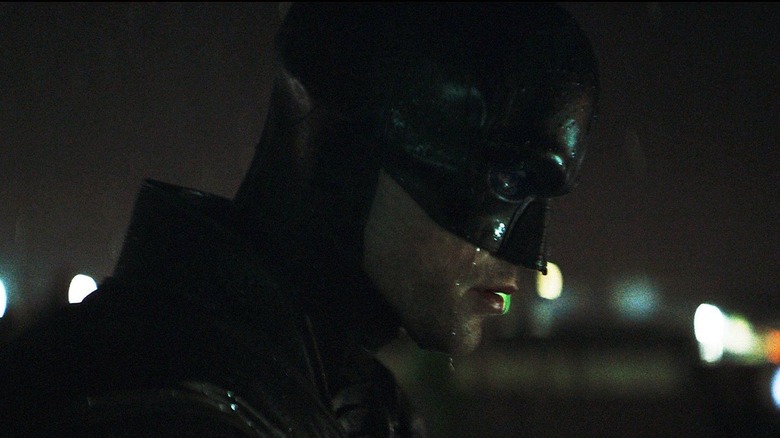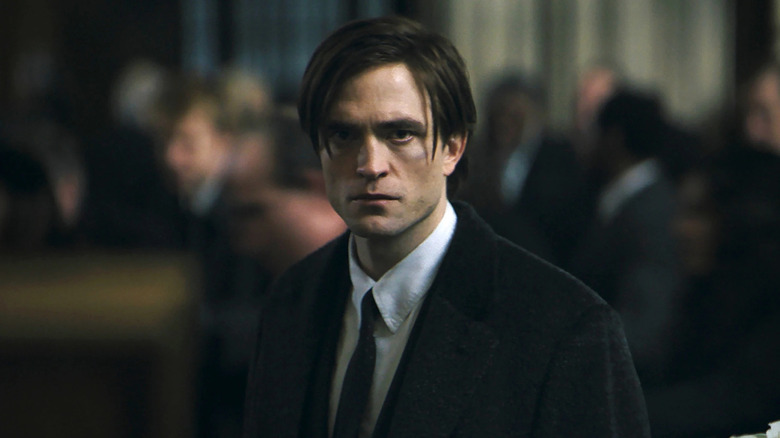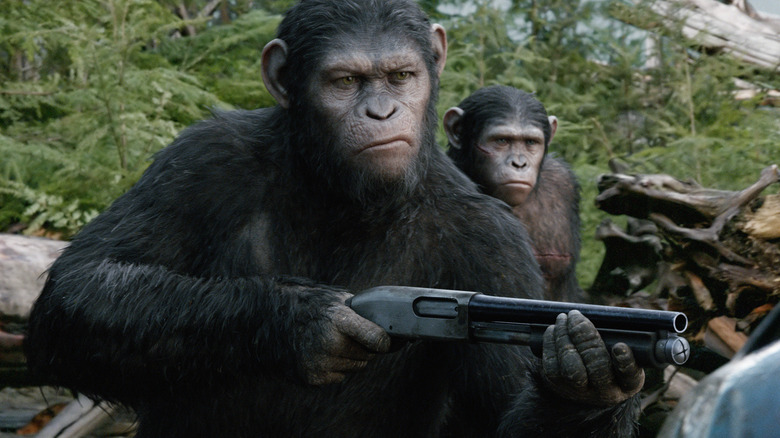How Composer Michael Giacchino Changed The Batman's Score To Reflect Bruce Wayne's Journey [Exclusive]
Playing the opening strains of Michael Giacchino's Bruce Wayne theme as it was heard in the 2022 film "The Batman" is quite simple, and can be explained even by a layman like me. In 4/4 time, play a B♭ three times in a row, a dotted quarter note, then an eighth note, then a quarter note. Then play a G♭ quarter. Repeat as many times as you like. It's very similar to the first section of John Carpenter's theme for "Halloween," or John William's opening notes in "Jaws," in that the basics are easy for even the most bumbling amateur to work out on a keyboard. Also, like "Halloween" and Jaws," Giacchino's theme is quickly expanded and overlaid with other melodies, tones, and musical counterpoints that make the simple bass melody a mere spine to a much more complicated animal.
The two-note Bruce Wayne theme is effective and instantly recognizable. It's one of those rare movie themes that stick in the brain. It's one of the better elements of Matt Reeves' heavily stylized movie.
At the beginning of "The Batman," Bruce Wayne's approach to Batman-ing is very violence-forward. He wishes to strike fear into the hearts of criminals and growls unhappily "I am justice" while pounding them in the face with his fists. By the end of the film, a villain has co-opted his catchphrase, and Bruce Wayne realizes that Gotham City would be better served by a Batman who behaves a little more like a superhero. In a recent interview with /Film's own Jack Giroux, Giacchino talked about how his theme was used throughout "The Batman," and how subtle changes were used to reflect Bruce Wayne's transformation from Spirit of Darkness to helper of the public.
Changing after three hours
Warning: Spoilers ahead for "The Batman."
At the end of "The Batman," after the Riddler (Paul Dano) has been apprehended, he and Batman have a conversation about forcing change onto a city that seems beyond redemption. Batman felt that he was stopping crime and being righteous, but it seems the Riddler was similarly motivated. They also both wear masks and do a great deal of violence to unarmed people, making them frighteningly similar. It's not until this scene that Batman begins to consider his role as a hero. Prior to this, "The Batman" is an otherwise straightforward (if complicated) story of police corruption and the exploitation of women. At the end of the film, Batman will have to reveal himself to the public as a helper, and finds himself out in the open, guiding people out of a flooded building and lifting them to safety.
The moment when Batman lights a flare to lead the citizens of Gotham out into the sun is the moment Giacchino felt the score must change. Bruce Wayne was now a new kind of hero. After three hours of film, punctuation was needed. He said:
"[T]here's moments where you can kind of hear that change when he lights that flare at the end, when he realizes that he's meant to be a light for these people as opposed to something that hides in the shadows. What if we made a very poignant version of that theme? It just seemed to work really well. Suddenly it felt, because this was something you've been hearing for the past couple of hours and now to hear it in this way, it's just suddenly much more emotional."
Working with Matt Reeves again
"The Batman" marked the fifth collaboration with Giacchino and Reeves. The two had previously worked together on "Dawn of the Planet of the Apes" and "War for" the same, as well as the vampire film "Let Me In." Giacchino also composed the closing theme for Reeves' 2008 film "Cloverfield." The two clearly worked well together, and Giacchino admits that he knew how to tug on his collaborator's heartstrings. In turn, the composer feels that Reeves was an expert in creating notably human characters in his otherwise fantasy landscapes.
It seems it was a pointed effort as to who could make the other cry. In his words:
"They are so human, his characters are so human. When you watch the 'Apes' movies, there are moments you want to cry in those movies too. He's crafting real people for you. They just happen to be an ape or happen to be wearing this bat suit. So it's really an incredible gift that Matt has, so he allows me to bring in the emotion. I'm always like, 'Matt, this is going to make me cry.' And he's like, 'Great, good. I want that. Make us cry.' Well, it's happening. The music reflects how I feel about something when I'm working on it."
The thought of Giacchino and Reeves sitting together in the studio, watching and listening to each other's work, holding each other, softly weeping ... it's such a glorious, touching image. Getting into the emotional heart of the scene seems to be Giacchino's operational ethos, and he'll often ask himself what kind of music would make him feel afraid, elevated, or triumphant.
Beginning with only two notes, that triumph is felt in the final, long-awaited scenes of "The Batman." As a composer, he succeeded.


